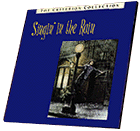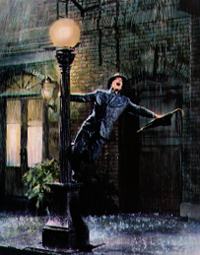

USA music
1952
color 103 min.
Director: Gene Kelly
CAV: out-of-print collectible
2 discs, catalog # CC1152L
CLV: out-of-print collectible
1 disc, catalog # CC1210L

Singin' in
the Rain is, in the opinion of most contemporary film critics, one
of the great movies of the sound era. The mere mention of its title
brings a smile to the face of every movie lover, regardless of
age. Its central image, that of Gene Kelly joyfully dancing and
hanging exuberantly from a lamppost during a downpour, has come to
exemplify not only the best of the M-G-M musical but also the high
point, the full flowering of the American musical genre. And yet it
was not always so. When Singin' in the Rain first burst upon an
unsuspecting moviegoing public in 1952, it was advertised as "the new
entertainment thrill from the studio and the star who gave you the
Academy Award-winning musical An American in Paris." It opened
in most first-run theatres across the country in April, just in time
for Easter, and faced formidable competition. 1952 was a watershed
year for Hollywood, and as a moviegoer that month, you had your choice
of Cecil B. DeMille's circus epic The Greatest Show on Earth;
John Huston's adventure-romance The African Queen; With a
Song in My Heart, the Technicolor musical biography of singer Jane
Froman; Elia Kazan's Viva Zapata! starring Marlon Brando; Fritz
Lang's Rancho Notorious starring Marlene Dietrich; Fred
Zinnemann's High Noon starring Gary Cooper; Joseph
L. Mankiewicz' Five Fingers starring Judy Holiday; and a
re-issue of the Disney classic Snow White and the Seven
Dwarfs.Singin' in the Rain received good reviews, with
most critics remarking it was not quite the equal of the
aforementioned An American in Paris. The picture played around
the country for the next several months very successfully, taking in
$7,500,000, making it one of the top grossing films of the year. At
year's end, however, it did not appear on any critic's "10 Best
Pictures of the Year" list, and when the Academy of Motion Picture
Arts and Sciences gave out the "Oscars," Singin' in the Rain
lost in the two categories in which it had been nominated (Best
Scoring of a Musical Picture [Lennie Hayton] and Best Supporting
Actress [Jean Hagen]. De Mille's The Greatest Show on Earth was
voted "Best Picture.") Thereafter, as with most movies of the time, it
disappeared from the nation's screens, but not, however, from the
hearts and memories of moviegoers.
Then, in early 1958, M-G-M began
a series of limited re-issues of some of its classic films under the
title "Masterpiece Reprints." Included in the first group of twelve
was Singin' in the Rain; this package was in constant
circulation for the next few years, playing short engagements in
theatres all over the country -- finally becoming a staple of the
burgeoning "revival" and "repertory" theatres that were springing up
in the major metropolitan areas in the late 1950s and early
1960s. Most importantly to the re-evaluation of Singin' in the
Rain, however, was the emergence, around this same time, of
college and university film societies, where, in addition to the study
of the standard American and European film classics from the teens and
twenties, some far-sighted professors were now including more
contemporary "entertainment" films in the study courses. It was
Pauline Kael, in program notes for a 1958 screening of the film at her
Cinema Guild repertory theatre in Berkeley, California, who first
pointed out that "Singin' in the Rain . . . is just about the
best Hollywood musical of all time." She was in the vanguard of a new
breed of film critics, raised on the delights of Hollywood
"entertainments" and persuasive in the argument that "there is more
energy, more originality, more excitement, more art in American kitsch
like . . . Singin' in the Rain than there is in the presumed
'High Culture' of . . . Hiroshima, Mon Amour . . ." This
revisionist attitude toward Hollywood "escapist" films on the part of
some influential critics (as opposed to "reviewers" -- and most
writing about film was limited to daily reviews until the late 1950s)
explains why Singin' in the Rain was ultimately elevated to the
pantheon of "great films." However, inclusion in this category does
not necessarily inspire the love and devotion of the mass movie-going
public.
Singin' in the Rain, due to its constant theatrical
circulation and its frequent prime-time telecasts in the 1960s, became
one of the most familiar and beloved musicals of our time. This was
due partly to the reasons listed by Ms. Kael: energy, originality,
excitement. It's also due to the screenplay of Betty Comden and Adolph
Green, which, shorn of its musical interludes, could still stand on
its own as one of the funniest comedies ever written. Set in Hollywood
in the late 1920s, when the changeover from silents to talkies was
wreaking havoc with careers, economics, production methods and story
styles, the script paints an affectionately satiric, humorous and
(somewhat) accurate picture of a time, a place and art/ industry. The
songs were almost all written by the picture's producer Arthur Freed
and his partner Nacio Herb Brown during the era in which the picture
is set, and all were written for early musicals. (The exceptions:
"Make 'Em Laugh," written by Freed and Brown especially for Donald
O'Connor in the film, and "Moses Supposes" by Comden, Green and Rodger
Edens.) Contrary to a trend that had begun on Broadway in the 1940s,
there was no attempt in Singin' in the Rain to "integrate" the
musical numbers into the plot or make them indicators of
character. Instead, the screenplay serves as the framework for a
succession of exhilarating musical numbers which exist for no other
reason than to bring pleasure and visual stimulation to the
audience.
The co-direction by Stanley Donen and the film's star Gene
Kelly distills the essence of all the performance styles out of which
the musical comedy genre emerged: Vaudeville, revue, ballet, tap and
jazz dancing -- all of which were combined with rare precision and
fused perfectly in Singin' in the Rain. The performances of the
leads (especially Jean Hagen's nasally vacuous "Lina Lamont"), the
singing, dancing, production numbers, the dialogue, the pacing, energy
and the overall joy and exuberance of the movie are what makes
Singin' in the Rain one of the great films. It's a picture that
can be seen over and over again with no loss of its high spirits, its
good nature, its wit, humor, energy and imagination. It is, in the
words of New York Times film critic Vincent Canby: ". . . an
always youthful, joyously indestructible . . . Hollywood masterpiece."
-- RONALD HAVER
Credits
Directors: Gene Kelly, Stanley
Donen
Producer: Arthur Freed
Story and Screenplay: Adolph Green,
Betty Comden
Director of Photography: Harold Rosson, A.S.C.
Art
Directors: Cedric Gibbons, Randall Duell
Film Editor: Adrienne
Fazan, A.C.E.
Recording Supervisor: Douglas Shearea
Music: Nacio
Herb Brown
Lyrics: Arthur Freed
Musical Director: Lennie
Hayton
Musical numbers staged and directed by: Gene Kelly, Stanley
Donen
Set Decorators: Edwin B. Willis, Jacque Mapes
Costumes:
Walter Plunkett
Transfer
This edition of Singin' in
the Rain was transferred from an archival 35mm CRI ( color
reversal internegative).






